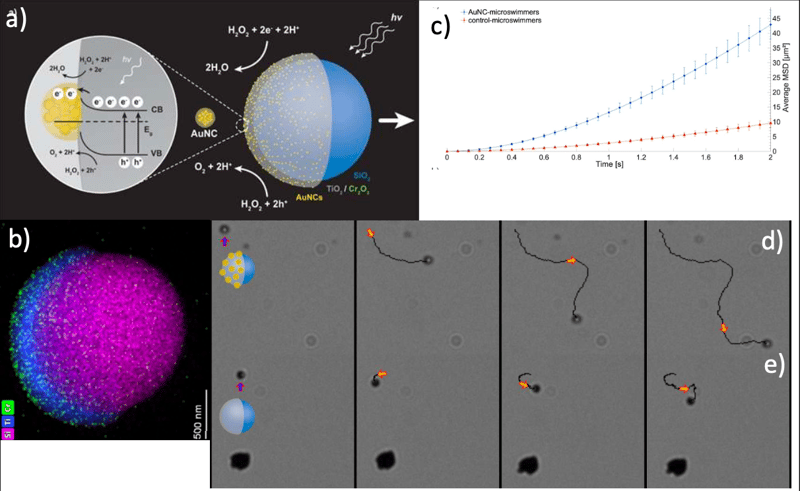Highlights

Oct 17, 2025
Materials Interfaces Research and Access (MIRA-PREM)
Enhanced active matter photocatalysis via Gold Nanoclusters
J. Martinez and G. Montaño (co-Pls), Northern Arizona University
In a paper titled Enhanced active matter photocatalysis via Gold Nanoclusters, researchers show that atomically precise gold nanoclusters can act as motility catalysts for active-matter microswimmers. By exploiting the nanoclusters’ tiny size and controllable optical activity, they achieve nearly fivefold higher mean-square displacement under UV light than conventional TiO2-based microswimmers. The work opens a path to add new functionalities to microswimmers by using the diverse properties of gold nanoclusters.

Oct 17, 2025
Materials Interfaces Research and Access (MIRA-PREM)
¡MIRA!-PREM: Sparking Curiosity In Materials Science!!
Northern Arizona University (Montaño)
During UT-Austin’s STEM Girl Day on Feb 22, 2025, the SparCS team from NAU ¡MIRA!-PREM highlighted its outreach work. Joined by the Center for Dynamics and Control of Materials, students, faculty, and staff introduced SparCS to the Austin community. They led hands-on activities for hundreds of middle-school girls and their families to spark interest in materials science, quantum tech, and photonics, making STEM fun and accessible.

Jul 31, 2025
TxState-UT PREM Center for Intelligent Materials Assembly (CIMA)
Conference Across MRSEC and PREM Schools (CAMPS)
Tania Betancourt, Texas State University
Texas State University hosted the 2025 Conference Across MRSEC and PREM Schools (CAMPS), bringing together 94 students from over 30 universities. The event featured a speaker series with faculty and industry presenters, rapid-fire oral presentations, and poster sessions. Attendees also participated in a career panel, networking lunch, and toured research labs to learn about materials characterization equipment, including electron microscopy tools. The conference aimed to foster collaboration and networking among students and professionals in the field.

Nov 20, 2024
Partnership for Education and Advancement of Quantum and nano-Sciences (PEAQS)
Integration of a Novel Biomembrane into a Lung-on-a-Chip Microfluidic Test-Platform
Jeff Jessing, Fort Lewis College
The Lung-on-a-Chip team at Fort Lewis College developed a novel fabrication method to produce a viable porous silicon biomembrane that mimics the functionality of the human interstitial space that separates the alveolar cells and the capillary cells where the gas exchange occurs in the lungs.

Nov 20, 2024
Partnership for Education and Advancement of Quantum and nano-Sciences (PEAQS)
Single Crystal Growth of Quantum Materials
Doyle Temple, Norfolk State University
PEAQS students have begun to grow and characterize more than half a dozen new crystals, including CaFe2 4, Ba-doped CaFe2 4, CuBiz 4, MgCr204, BaFeGaO4, PdGa, and PiGa.

Nov 20, 2024
Partnership for Education and Advancement of Quantum and nano-Sciences (PEAQS)
Community Building at the PEAQS Student Retreat
Sarah Schreiner, CU Boulder
PEAQS hosted its first student retreat March 25-26th at CU Boulder.

Nov 20, 2024
Partnership for Education and Advancement of Quantum and nano-Sciences (PEAQS)
An Optical/Electrical System for Micro Droplet Screening
Yiyan Li, Fort Lewis College
The undergraduate researchers at Fort Lewis College developed a microscope and an optical signal detector circuit to quantify single bacterium in microdroplets from environmental water samples.

Nov 20, 2024
Partnership for Education and Advancement of Quantum and nano-Sciences (PEAQS)
PEAQS student pathways
Sarah Schreiner, CU Boulder
"I never realized how much this experience would make me a perfect fit for this career."

Nov 20, 2024
Partnership for Education and Advancement of Quantum and nano-Sciences (PEAQS)
An Optical/Electrical System for Micro Droplet Screening
Yiyan Li, Fort Lewis College
The undergraduate researchers at Fort Lewis College developed an optical system to quantify single bacterium
from environmental water samples. To improve signal detection in their system, they developed a neural network, a method in artificial intelligence.
